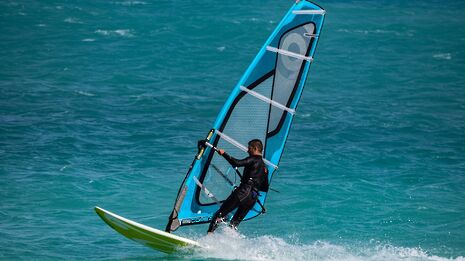New to a Blue: Cambridge University Gliding Club
Enticed by the prospect of freeing your inner bird? Club President Chris Barrott talks to Varsity about Blues gliding

This week, in Varsity’s exploration of the lesser known sports around Cambridge, we look to the skies and Cambridge University Gliding Club. To find out about one of the more outlandish sports on offer, we caught up with Chris Barrott, the club president, whose gliding exploits have taken him to the farthest corners of the UK.
For readers who have hitherto kept both feet firmly on the ground, Barrott explained the basics: “Gliding is the sport of flying unpowered aircraft. We use the same naturally occurring rising air currents as birds do to ‘soar’ the skies and fly for great distances. We rely on different forms of rising air and, once the skill has been mastered, we are able to fly for hundreds of kilometres, several hours or to high altitudes.”
Founded by undergraduates in 1935, the club’s previous members include NASA astronaut and Queens’ College graduate Michael Foale, who used the gliding club to amass hours in the air on his way to a pilot license and, ultimately, a record-breaking six-month commandment of the International Space Station.
In case, somehow, you are not immediately convinced by the prospect of freeing your inner bird, not to mention taking a step in the direction of realizing every child’s dream and becoming an astronaut, Barrott continued his easy sell: “most people are hooked as soon as they take a trial flight. It’s silent flight, with a brilliant view. It’s as close to flying like birds as possible, and often you can even fly alongside them. It’s also the cheapest way to fly, and once a certain level is reached can be converted to an international pilot’s license. Many members join aspiring to fly powered aircraft, then realise the true fun lies in gliding!”
Not only is gliding the cheapest way to fly in general, but apparently the Cambridge University Gliding Club offers the cheapest, most low commitment gliding anywhere in the country, with members paying per flight and only flying when it can be comfortably integrated into busy Cantab timetables.
Understandably, many students never in their wildest dreams imagine that they could be partaking in a post-supervision flight across panoramic East Anglian countryside as their everyday stresses and responsibilities are left several miles below them. But with the unique opportunity provided by the gliding club, it seems the sky truly is the limit.
Gliding as close to flying like birds as possible and often you can even fly alongside them
Following initial innovations by the Wright brothers at the dawn of the 20th century, gliding as a sport first took off in Germany after the conclusion of World War I. One condition of the Treaty of Versailles was the imposition of severe restrictions on the use of single-seat powered aircraft within German borders.
Not to be kept out of the skies for long, the country’s aviators and aircraft makers swiftly developed ever more efficient non-powered gliders that used rising warm air currents to propel more than 50,000 glider pilots into the skies by 1937.
The first gliding competition was held in 1920 and the Cambridge University Gliding Club continues this tradition today with its annual summer Varsity match. As Chris Barrott reports, “We are pretty even with Oxford, with victories being about 50/50 in recent years – but we have a strong team lined up for this year!”
“The competition is simple: gain as much height as you can in a flight of 50 minutes. Points are awarded for hundreds of feet gained, and for time flown up to the 50 minute limit. We are planning our first ever aerobatics Varsity in winter 2018 following some successful aerobatics training days in the past year.”
By competing, along with having reached bronze badge standard according to the British Gliding Association (which usually takes one to two years), pilots can achieve half-Blue status.
So, for those (like this writer) who are thoroughly persuaded and ready to take wing, Barrott said: “The best way to get involved is to take a trial flight. These are taster sessions aimed at the complete beginner and include a short flight with a chance to have a go on the controls of the glider”, also pointing interested parties towards the club website and Facebook page for any further enquiries.
Once they have become members, students can book in for training slots seven days a week with professional instructors from the club’s partner, the Cambridge Gliding Centre at Gransden Lodge airfield, 13 miles to the west of Cambridge. The first goal for rookie gliders is to gain the required proficiency to fly solo, but the process of learning is surely an end in itself.
Barrott assured us that “We’re a very friendly club, and there are very few limitations on who can fly a glider (basically the same medical requirements for driving). It’s not as expensive as you might expect, and anyone of any experience level can join.” What’s not to like?
 News / Cambridge welcomes UK rejoining the Erasmus scheme20 December 2025
News / Cambridge welcomes UK rejoining the Erasmus scheme20 December 2025 News / CUP announces funding scheme for under-represented academics19 December 2025
News / CUP announces funding scheme for under-represented academics19 December 2025 News / News in Brief: humanoid chatbots, holiday specials, and harmonious scholarships21 December 2025
News / News in Brief: humanoid chatbots, holiday specials, and harmonious scholarships21 December 2025 News / SU reluctantly registers controversial women’s soc18 December 2025
News / SU reluctantly registers controversial women’s soc18 December 2025 News / King appoints Peterhouse chaplain to Westminster Abbey22 December 2025
News / King appoints Peterhouse chaplain to Westminster Abbey22 December 2025









